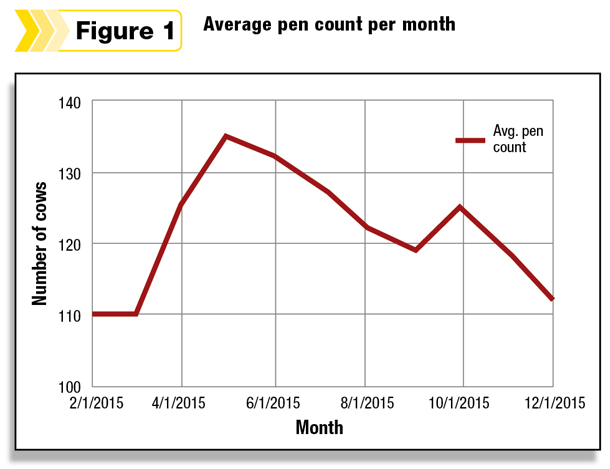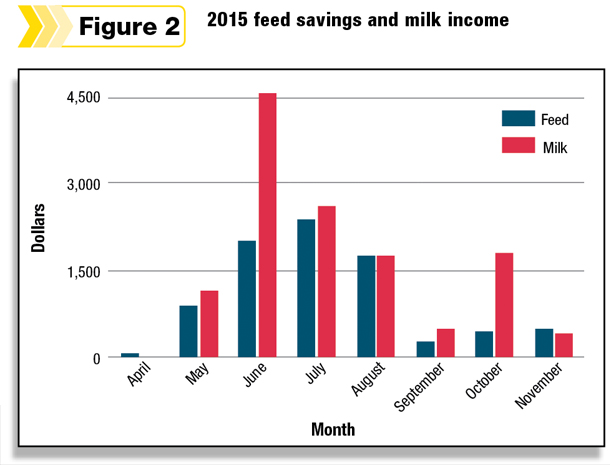There seems to be two viewpoints when it comes to grazing. It is either grain is poison, or grass is poison. Maybe those are just the loudest voices from either end of the spectrum, and we don’t hear much from the views that lie somewhere in the middle.
The “grain is poison” crowd likes to hang their hat on CLA, omega-3, save the world and cow health. While the “grass is poison” crowd swears that if they turn their 100-pound producing cows out in the sun, they could die, or worse!
I am somewhere in the middle when it comes to grazing. I like to get the cows outside as much as I can – there is something romantic about the cows being in the pasture – but I also need to make a lot of milk.
The old mud lot
Our low group lives in this conglomerate of barns that was the original farmstead. What once was a 30-cow stanchion barn with a machine shed and horse stable in 1960 is now a hodgepodge of 75 freestalls and pack space for about 40 cows, with various scrape alleys that seem to only flow uphill. The original barns also had the original “meadow,” as they call it in Pennsylvania. This 6-acre piece was probably fine to let the 30 cows out onto in the summer evenings. Fast forward 50 years and we are still using the “meadow”; only now the herd size is actually only one of the groups, of 110, with free choice access in and out. The only thing growing in this lot was mud.
In the spring of 2014, I decided I was going to do something about the mud. I rolled out some polytape on one side of the field, the whole length of the 6 acres, to make a lane. The field is a fairly even rectangle. I paced it out, roughly 220 feet wide and 1,100 feet long. My goal was to have a 30-day rotation on the grass/dirt, to let the grass come back, but still have the cows outside. I could give them 36 feet per day and move the back fence every three days to keep the grass growing. A patch of grass 36 feet by 220 feet (two-tenths of an acre) for 110 cows doesn't look like much space.
The feed
I wasn't worried about the grass as a feed source. I knew they would chew on it, but nothing was really there to eat. I had plenty of feed and no intention to park my mixer. The more I rotated the cows, the more grass I grew. The more the grass grew, the more the cows ate it. The more grass they ate, the less TMR they ate. A vicious cycle, really. Instead of adjusting the diet, I just fed for a few less cows. This is when it started to click. I had grass growing where mud used to be; the cows could get out of the hot barn; and I could still get them to eat their feed.

Getting by on good looks
After seeing the fast improvements I was making growing grass with a heavy stocking rate, in 200-bushel corn country, I was worried the grass would soon be too good. I needed to bring more cows into the equation. I would rather feed a lot of cows a little grass than a few cows a lot of grass. With the progress that was being made on “the old mud lot,” I was able to take on an adjacent 11-acre alfalfa stand. We interseeded ryegrass, white clover and chicory in the fall of 2014. My intention was to let the seeding get established by taking off first cutting in the spring of 2015 as haylage instead of grazing.
In the spring of 2015, I put 135 cows in my group that typically runs about 110. I needed the extra mouths to keep up with the grass. I had no intention of altering the ration. It was working fine just to feed for a few less cows depending on refusals. At the peak of the 2015 season, I was replacing the equivalent of 6 pounds of dry matter per cow of TMR with grass. I used DairyComp to break out that group and track their production and cow numbers on a daily basis. I also used an Excel spreadsheet to track my TMR feed outs and refusals to have somewhat of an accurate dry matter intake for this group. I wanted to know what we could get by with and watch the tank response.

The results are promising
My grazing season in 2015 started on April 30, and I closed the gate on Dec. 4. Any day that my grazing group had cow numbers over my winter pen count of 110, I counted those as extra cows. Rotating the cows allowed me to milk a total of 1,089 extra cows over the course of the season. For the season, my best estimate of the total pounds of dry matter coming from pasture was 58,600 (1.72 tons per acre). In 2015, my TMR costs per pound of dry matter was $.13. In essence, pasture replaced $7,618 in feed costs for the season.
The real money came from the milk of the extra cows. I tallied the number of extra cows milked each month along with the average production from the group and multiplied those milk weights by our monthly mailbox price. For the season, the extra milk totaled a gross revenue of $12,898.32. The combined figure of feed saved ($7,618) and extra milk income ($12,898.32) returned a total of $20,516.32 to the farm for the season. These are gross figures. We did spend $2,500 on some lane improvements, $2,000 to beef up the fencing and $800 on some seed no-tilled into an old alfalfa stand. I also didn’t put a value on the land or dry matter from pasture. It was a mud hole when I started.
Today
This season my goal was to push the numbers to 150 cows. That lasted for about a week. Currently, I am running 160 head in this group. They are eating about 4 pounds of dry matter from pasture. These Jerseys are milking 52 pounds of 4.3 percent butterfat and 3.5 percent protein at 231 days in milk. Total feed cost per cow per day is $4.32. For the time being, 160 is my max. Not altering the ration and moving the fence has been the only way running this many cows on so little ground has worked. If I had changed the ration to accommodate grass, bunk space would be a serious issue. If I didn’t move the fence, the cows would turn it back to mud.
The future
With my current facility, I am at my max cow number of 160 for my low group. If the gates were closed, I would never attempt to run my pen counts at 45 percent over. Overall we have been able to maintain the production on the group and lift the daily production of the whole farm. The mud hole that used to be an eye sore has turned into a $20,000 revenue generator. Turning our low group outside and increasing the capacity has put the farm in a good position to take on the lower milk price this year. PD
For more articles like this and other powerful techniques for herd managers, check out the Dairyhack website.

-
Jim VanDerlinde
- Dairy Producer, Consultant
- Hillview Dairy
- Lewisburg, Pennsylvania
- Email Jim VanDerlinde
PHOTO: Jim VanDerlinde was able to turn an unused lot on the farm into a grazing paddock and net about $20,000. Photo provided by Jim VanDerlinde.



